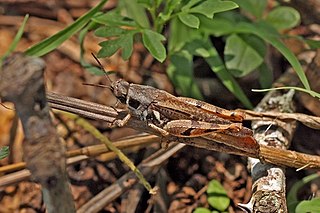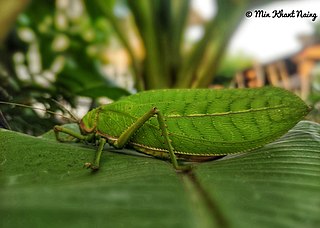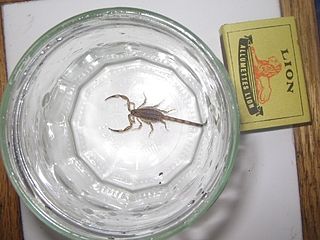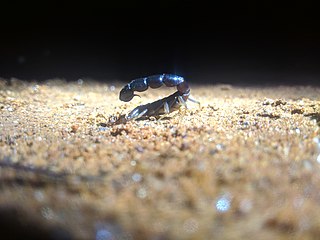
The skimmers or perchers and their relatives form the Libellulidae, the largest dragonfly family in the world. It is sometimes considered to contain the Corduliidae as the subfamily Corduliinae and the Macromiidae as the subfamily Macromiinae. Even if these are excluded, there remains a family of over 1000 species. With nearly worldwide distribution, these are almost certainly the most often seen of all dragonflies.

The subfamily Catantopinae is a group of insects classified under family Acrididae. Genera such as Macrotona may sometimes called "spur-throated grasshoppers", but that name is also used for grasshoppers from other subfamilies, including the genus Melanoplus from the Melanoplinae.

The grasshopper subfamily Acridinae, sometimes called silent slant-faced grasshoppers, belong of the large family Acrididae in the Orthoptera: Caelifera.

Gynacantha is a genus of dragonflies in the family Aeshnidae. The females have two prominent spines under the last abdominal segment. This gives the genus name and the common name two-spined darners; they are also known as duskhawkers.

Heliaeschna is a genus of dragonflies in the family Aeshnidae.
Barombia is a genus of grasshoppers in the subfamily Catantopinae with no tribe assigned. Species can be found in Cameroun.
Ferdinand Anton Franz Karsch was a German arachnologist, entomologist and anthropologist. He also wrote on human and animal sexual diversity with his mother's maiden name included as FerdinandKarsch-Haack from around 1905.

Pilodeudorix is a genus of butterflies in the family Lycaenidae. They are found in the Afrotropical realm.

The subfamily Pseudophyllinae contains numerous species in the family Tettigoniidae, the katydids or bush crickets. Sometimes called "true katydids", together with the crickets of suborder Ensifera, they form part of the insect order Orthoptera which also contains grasshoppers.
Hemiceratoides is a genus of moths of the family Erebidae.

The Phaneropterinae, the sickle-bearing bush crickets or leaf katydids, are a subfamily of insects within the family Tettigoniidae. Nearly 2,060 species in 85 genera throughout the world are known. They are also known as false katydids or round-headed katydids.

Sarangesa is a genus of skippers in the family Hesperiidae. Most of the species in the genus are found in the Afrotropical realm, while a few are in the Indomalayan realm.

Smerinthini is a tribe of moths of the family Sphingidae. The genus was erected by Augustus Radcliffe Grote and Herbert C. Robinson in 1865.

Bicyclus is a butterfly genus from the subfamily Satyrinae in the family Nymphalidae. The species are found in the Afrotropical realm.

Papilio fuelleborni is a species of swallowtail butterfly from the genus Papilio that is found in Tanzania and Malawi.

Euriphene is a butterfly genus in the subfamily Limenitidinae. The 70 or so member species are confined to the Afrotropical realm. They are found mainly in the Guinean Forests of West Africa and the Congolian forests.

Isometrus is a genus of scorpion belonging and being eponymous to the family Buthidae. Some species are currently assigned to the genus Reddyanus.

Mecopodinae are a subfamily of bush crickets found in western South America, sub-Saharan Africa, and Asia. In Asia, the distribution includes India, Indochina, Japan, the Philippines, and Malesia to Papua New Guinea and Australasia, including many Pacific islands.
Heterothele is a genus of South American and African tarantulas that was first described by Ferdinand Anton Franz Karsch in 1879.

Buthoscorpio is a genus of scorpions in the family Buthidae.
















